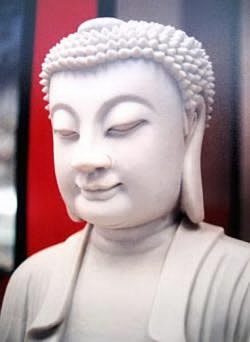Difference between revisions of "Dharmaskandha"
(Created page with "thumb|250px| Dharmaskandha or Dharma-skandha-sastra is one of the seven Sarvastivada Abhidharma Buddhist scriptures. Dharmaskandha me...") |
|||
| Line 1: | Line 1: | ||
[[File:Sb77.jpg|thumb|250px|]] | [[File:Sb77.jpg|thumb|250px|]] | ||
| − | [[Dharmaskandha]] or [[Dharma-skandha-sastra]] is one of the seven [[Sarvastivada | + | [[Dharmaskandha]] or [[Dharma-skandha-sastra]] is one of the seven [[Sarvastivada Abhidharma]] [[Buddhist scriptures]]. [[Dharmaskandha]] means "[[collection of dharmas]]". It was composed by [[Sariputra]] (according to the [[Sanskrit]] and [[Tibetan]] sources) or [[Maudgalyayana]] (according to {{Wiki|Chinese}} sources). The {{Wiki|Chinese}} edition was translated by [[Xuanzang]], and appears as: T26, No. 1537, in 12 fascicles. It begins with a [[matrka]] as a summary of the topics, showing its antiquity, as these were supposedly only assigned by the [[Buddha]] himself. It presents 21 [[subjects]], the first 15 of which [[concern]] the practice of the [[spiritual]] [[path]], and the [[realization]] of its {{Wiki|fruits}}. The 16th deals with "various issues". [[Subjects]] 17 to 20 deal with the {{Wiki|enumeration}} of the [[ayatanas]], [[dhatus]] and [[skandhas]] as encompassing "all [[dharmas]]". The 21st is regards [[dependent origination]]. |
| + | |||
| + | {{Wiki|Frauwallner}} concludes that the [[Dhatuskandha]] is from a period before then split between the [[Sanskrit]] and [[Pāli]] [[Abhidharma]] [[traditions]], based on its correlation with the [[Pāli]] [[Vibhanga]]. He thus dates it to pre-[[Ashoka]] [[Buddhism]]. [[Yin Shun]] notes it being mentioned in the [[Mulasarvastivada]] [[Vinaya-vyakaraṇa]], indicating its early inclusion in the [[Sarvastivada]] [[canon]]. These two combined, would suggest the [[Mulasarvastivada]] having its own [[canon]] at quite an early date. [[Yin Shun]] also cites three points for considering this text to be sourced in a pre-sectarian [[Abhidharma]]. It similar {{Wiki|analysis}} of [[rupa]] to the [[Sariputta Abhidhamma]] and the [[Dhammapariyaya]] (considered to be the oldest [[Abhidharma]] texts of any [[tradition]]). No mention of [[avijnapti-rupa]], as per the [[Sariputta Abhidhamma]]; and [[Yin Shun]]. The {{Wiki|emphasis}} on the five [[indriya]] and five [[bala]], as paramount in the [[spiritual path]]. | ||
{{R}} | {{R}} | ||
[http://www.tamqui.com/buddhaworld/Dharmaskandha www.tamqui.com] | [http://www.tamqui.com/buddhaworld/Dharmaskandha www.tamqui.com] | ||
[[Category:Sarvāstivāda]] | [[Category:Sarvāstivāda]] | ||
Revision as of 03:12, 1 January 2015
Dharmaskandha or Dharma-skandha-sastra is one of the seven Sarvastivada Abhidharma Buddhist scriptures. Dharmaskandha means "collection of dharmas". It was composed by Sariputra (according to the Sanskrit and Tibetan sources) or Maudgalyayana (according to Chinese sources). The Chinese edition was translated by Xuanzang, and appears as: T26, No. 1537, in 12 fascicles. It begins with a matrka as a summary of the topics, showing its antiquity, as these were supposedly only assigned by the Buddha himself. It presents 21 subjects, the first 15 of which concern the practice of the spiritual path, and the realization of its fruits. The 16th deals with "various issues". Subjects 17 to 20 deal with the enumeration of the ayatanas, dhatus and skandhas as encompassing "all dharmas". The 21st is regards dependent origination.
Frauwallner concludes that the Dhatuskandha is from a period before then split between the Sanskrit and Pāli Abhidharma traditions, based on its correlation with the Pāli Vibhanga. He thus dates it to pre-Ashoka Buddhism. Yin Shun notes it being mentioned in the Mulasarvastivada Vinaya-vyakaraṇa, indicating its early inclusion in the Sarvastivada canon. These two combined, would suggest the Mulasarvastivada having its own canon at quite an early date. Yin Shun also cites three points for considering this text to be sourced in a pre-sectarian Abhidharma. It similar analysis of rupa to the Sariputta Abhidhamma and the Dhammapariyaya (considered to be the oldest Abhidharma texts of any tradition). No mention of avijnapti-rupa, as per the Sariputta Abhidhamma; and Yin Shun. The emphasis on the five indriya and five bala, as paramount in the spiritual path.
